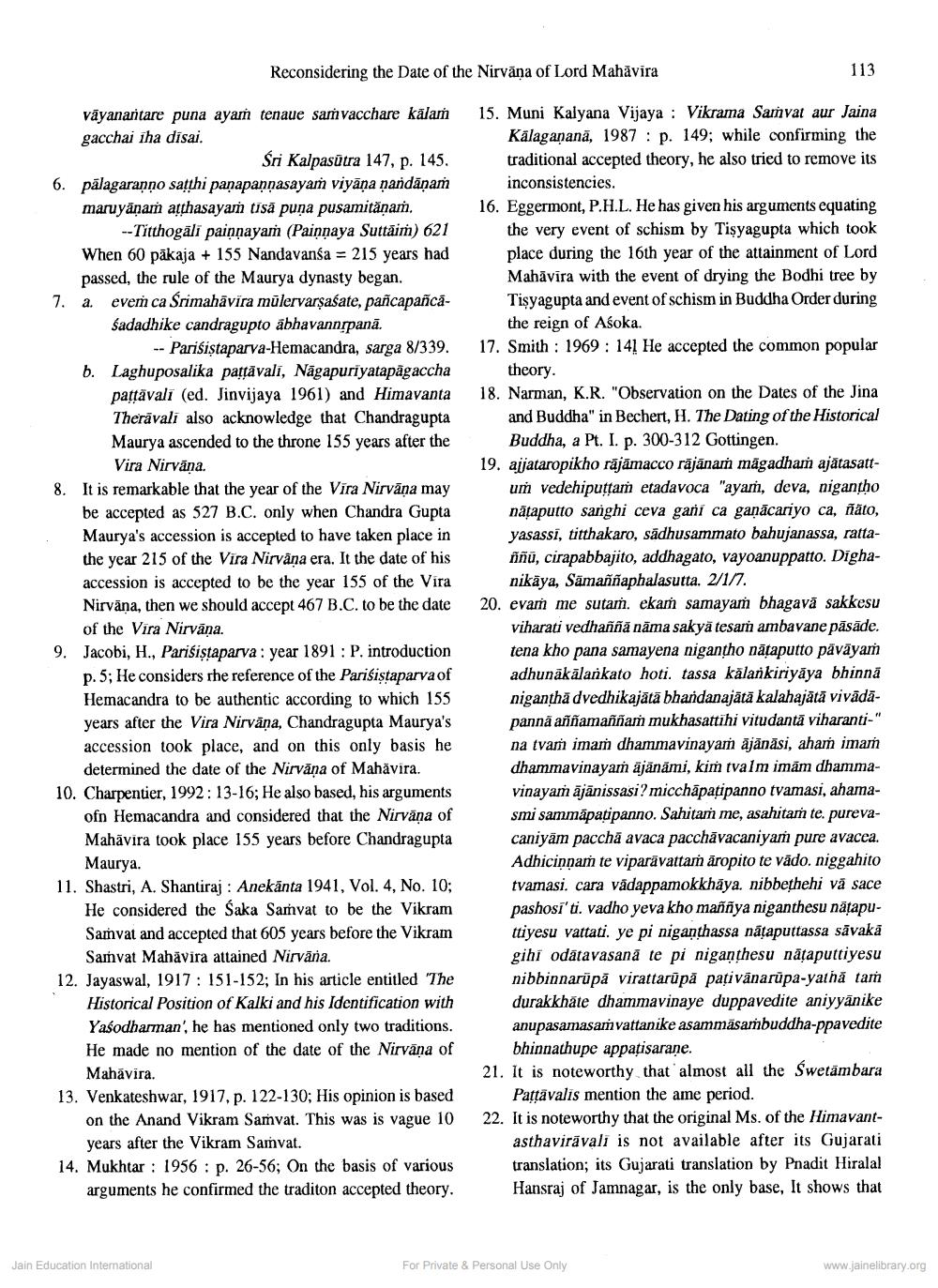Book Title: Reconsidering the date of Nirvna of Lord Mahavira Author(s): Sagarmal Jain Publisher: Z_Shwetambar_Sthanakvasi_Jain_Sabha_Hirak_Jayanti_Granth_012052.pdf View full book textPage 8
________________ Reconsidering the Date of the Nirvana of Lord Mahavira 113 vayanantare puna ayam tenaue samvacchare kalam gacchai iha disai. Sri Kalpasutra 147, p. 145. 6. palagaranno sasthi panapannasayam viyana nardanas maruyanam atthasayam tisa puna pusamitanam, --Titthogali painnayam (Painnaya Suttaim) 621 When 60 pakaja + 155 Nandavansa = 215 years had passed, the rule of the Maurya dynasty began. 7. a. evem ca Srimahavira mulervarsasate, pancapanca- sadadhike candragupto abhavannspana. -- Parisistaparva-Hemacandra, sarga 8/339. b. Laghuposalika pattavali, Nagapuriyatapagaccha patlavali (ed. Jinvijaya 1961) and Himavanta Theravali also acknowledge that Chandragupta Maurya ascended to the throne 155 years after the Vira Nirvana. 8. It is remarkable that the year of the Vira Nirvana may be accepted as 527 B.C. only when Chandra Gupta Maurya's accession is accepted to have taken place in the year 215 of the Vira Nirvana era. It the date of his accession is accepted to be the year 155 of the Vira Nirvana, then we should accept 467 B.C. to be the date of the Vira Nirvana. 9. Jacobi, H., Parisistaparva: year 1891 : P. introduction p. 5; He considers the reference of the Parisistaparvaof Hemacandra to be authentic according to which 155 years after the Vira Nirvana, Chandragupta Maurya's accession took place, and on this only basis he determined the date of the Nirvana of Mahavira. 10. Charpentier, 1992:13-16; He also based, his arguments ofn Hemacandra and considered that the Nirvana of Mahavira took place 155 years before Chandragupta Maurya. 11. Shastri, A. Shantiraj : Anekanta 1941, Vol. 4, No. 10; He considered the Saka Samvat to be the Vikram Samvat and accepted that 605 years before the Vikram Samvat Mahavira attained Nirvana. 12. Jayaswal, 1917 : 151-152; In his article entitled 'The Historical Position of Kalki and his Identification with Yasodharman', he has mentioned only two traditions. He made no mention of the date of the Nirvana of Mahavira. 13. Venkateshwar, 1917, p. 122-130; His opinion is based on the Anand Vikram Samvat. This was is vague 10 years after the Vikram Samvat. 14. Mukhtar : 1956 : p. 26-56; On the basis of various arguments he confirmed the traditon accepted theory. 15. Muni Kalyana Vijaya : Vikrama Samvat aur Jaina Kalaganana, 1987 : p. 149; while confirming the traditional accepted theory, he also tried to remove its inconsistencies. 16. Eggermont, P.H.L. He has given his arguments equating the very event of schism by Tisyagupta which took place during the 16th year of the attainment of Lord Mahavira with the event of drying the Bodhi tree by Tisyagupta and event of schism in Buddha Order during the reign of Asoka. 17. Smith : 1969 : 14! He accepted the common popular theory. 18. Narman, K.R. "Observation on the Dates of the Jina and Buddha" in Bechert, H. The Dating of the Historical Buddha, a Pt. I. p. 300-312 Gottingen. 19. ajjataropikho rajamacco rajanar magadham ajatasatt um vedehiputtam etadavoca "ayam, deva, nigantho nataputto sanghi ceva gani ca ganacariyo ca, nato, yasassi, titthakaro, sadhusammato bahujanassa, rattanna, cirapabbajito, addhagato, vayoanuppatto. Digha nikaya, Samannaphalasutta. 2/1/7. 20. evam me sutam. ekam samayam bhagava sakkesu viharati vedhanna nama sakya tesam ambavane pasade. tena kho pana samayena nigantho nataputto pavayam adhunakalarikato hoti. tassa kalarkiriyaya bhinna nigantha dvedhikajata bhandanajata kalahajata vivadapanna annamannam mukhasattihi vitudanta viharanti-" na tvam imam dhammavinayam ajanasi, aham iman dhammavinayam ajanami, kim tvalm imam dhammavinayam ajanissasi? micchapatipanno tvamasi, ahamasmi sammapatipanno. Sahitam me, asahitam te. purevacaniyam paccha avaca pacchavacaniyam pure avacea. Adhicinnam te viparavattam aropito te vado. niggahito tvamasi. cara vadappamokkhaya. nibbethehi va sace pashosi'ti. vadho yeva kho mannya niganthesu nataputtiyesu vattati. ye pi niganthassa nataputtassa savaka gihi odatavasana te pi niganthesu nataputtiyesu nibbinnarupa virattarupa pati vanarupa-yaina tam durakkhate dhammavinaye duppavedite aniyyanike anupasamasamvattanike asammasambuddha-ppavedite bhinnathupe appatisarane. 21. It is noteworthy that almost all the Swetambara Pattavalis mention the ame period. 22. It is noteworthy that the original Ms. of the Himavant asthaviravali is not available after its Gujarati translation; its Gujarati translation by Pnadit Hiralal Hansraj of Jamnagar, is the only base, It shows that Jain Education International For Private & Personal Use Only www.jainelibrary.orgPage Navigation
1 ... 6 7 8
